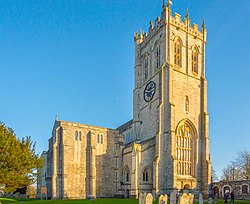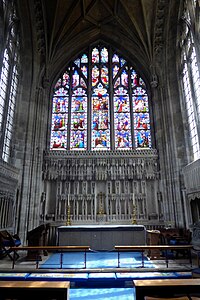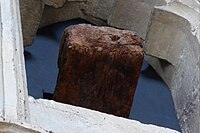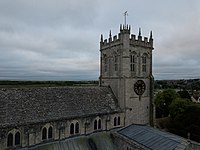Christchurch Priory
| Christchurch Priory | |
|
The Priory Church of | |
|---|---|
|
Hampshire | |
| Status: | Parish church |
 Christchurch Priory | |
| Church of England | |
| Diocese of Winchester | |
| Location | |
| Grid reference: | SZ160925 |
| Location: | 50°43’55"N, 1°46’29"W |
| History | |
| Information | |
| Website: | www.christchurchpriory.org |
Christchurch Priory is an parish church which before the Reformation was the church of the eponymous priory, in Christchurch in Hampshire. It is one of the longest parish churches in Britain and is as large as many of the Church of England's cathedrals.
Early history
The story of Christchurch Priory goes back to at least the middle of the 11th century, as the Domesday Book of 1086 says there was a priory of 24 secular canons here in the reign of Edward the Confessor. The Priory is on the site of an earlier church dating from around the year 800.[1] In this period the town was known as Twynham.
In 1094 a chief minister King William II, Ranulf Flambard, then Dean of Twynham, began the building of a church.
Local legend has it that Flambard originally intended the church to be built on top of nearby St Catherine's Hill but during the night all the building materials were mysteriously transported to the site of the present priory.[2]
In 1099, Flambard was appointed Bishop of Durham, but work continued under his successors. An account written in the mid-12th century recording the legend of the Christchurch Dragon indicates that by 1113 the new church was nearing completion under Dean Peter de Oglander. By about 1150 there was a basic Norman church consisting of a nave, a central tower and a quire extending eastwards from the crossing.
It was during this period that another legend originated, that of the miraculous beam, which is thought to have brought about the change in the name of the town from Twynham to the present day Christchurch, but in fact the two names both appear in a grant dated from 954 ('juxta opidum Twinam, id est, Cristescirce').[3]
Twelfth to fourteenth centuries

In 1150, Baldwin de Redvers, Lord of the Manor of Christchurch and Earl of Devon replaced the secular minster with an Augustinian priory. The de Redvers continued in their patronage of the priory for 150 years, until in 1293, Isabella de Fortibus, Countess of Devon (the last of the de Redvers line) sold her eastern estates to the King, Edward I, for about £4000.
By this sale, Christchurch became a Royal Manor which meant that in 1303 it was required to provide and man a ship to aid the King's campaign in Scotland.
In 1330 Baron William de Montacute was granted the manor by Edward III and thus became the 1st Earl of Salisbury (Second Creation).
In the 13th century there was a frenzy of building: the nave aisles were vaulted, the clerestory was built, the Montacute Chapels replaced the Norman apse in the north transept and work began on the North Porch, notable for its unusually large size.
Although there is no documentary evidence relating to a central tower, the massive piers and arches at the corners of the transepts seem to indicate provision was made for one.
A central tower would have been consistent with a Norman conventual church.[4]
Fourteenth to sixteenth centuries

Work continued in the 14th century. The nave roof reached its present height no later than 1350 and towards the end of the 14th century work on the Lady Chapel was started. It was completed in the early 15th century and its pendant vaulting is thought to be the first of its kind in England. Also in the 15th century, the original quire was replaced and extended so that it joined onto the new Lady Chapel. This may have been as a result of the Norman tower collapsing, but this is not certain. What is certain is that the tower was rebuilt between 1470 and 1480. The Draper and Salisbury chantry chapels were completed by 1529. By this time, the church looked much as it does today.
Christchurch Priory Cartulary
Much of what is known about Christchurch between the Norman Conquest and the mid-14th century comes from the Christchurch Priory Cartulary, which contains copies over 1,300 of the monastery's most important documents. Most of it was written by just two clerks, one completing more than half before a second concluded the task in 1372. Further amendments and updates were added in the following decades.
The existence of the cartulary in the Priory library was recorded by John Leland shortly before the Dissolution, but its whereabouts in the decades after 1539 are uncertain. Almost a century later it was in the library of Sir Robert Cotton, a notable collector of medieval manuscripts. In 1753 the Cotton library collection was acquired by the newly founded British Museum, but the Christchurch Priory Cartulary was thought lost until it was discovered in an old cupboard in a garret of the Museum in 1837. It is today held in the British Library, where it is still catalogued by Sir Robert Cotton's filing system, under 'Cotton MS Tiberius D.vi.'.
Efforts to translate the whole Cartulary began in the late 20th century, but not until 2007 was this task completed by Katharine Hanna.[5]
Miraculous beam

The legend of the miraculous beam dates to the early 12th century. The story is that a beam was found to have been cut too short when it was hoisted into place. This would have been embarrassing for the carpenters since the wood was expensive and would be difficult to replace. There was however a mysterious carpenter who had worked and eaten alone. The following day the carpenters returned and found the beam was now fitted in place. The unknown carpenter was never seen again, and the story came to be that it was Christ who had intervened. The church became Christ's Church of Twynham in commemoration of the event.[6] In time the town became Twynham-Christchurch and eventually shortened to Christchurch. The miraculous beam can be seen today and is located in the Priory's ambulatory.
Misericords
The Priory has 39 misericords, dating from three periods: 1250, 1350 and 1515. They show a mixture of mythological and folklore scenes, some of which appear to have been derived from Aesops fables. There are also some showing religious iconography, such as the emblems of St Mark and St Matthew.
Dissolution
King Henry VIII and Parliament determined the Dissolution of the Monasteries in 1538. On 28 November 1539, John Draper, the last prior of Christchurch, surrendered the priory, and it was |dissolved. Prior Draper was granted a pension of £133-6s-8d and the use of Somerford Grange for life.
The conventual buildings of the priory were pulled down soon after the dissolution. The King had intended to demolish the church as well as the conventual buildings, but in response to a plea from the townspeople, supported by Prior Draper, he granted it, together with the churchyard, to the churchwardens and inhabitants of Christchurch to be used as the parish church in perpetuity on 23 October 1540; a grant that was confirmed on 12 February 1612 by King James I.
Post-Dissolution

After the Dissolution a corporation known as 'The Sixteen' was formed which became responsible for the temporal and ecclesiastical affairs of the parish, with the vicar and churchwardens being the principal officers.
In 1788 Gustavus Brander gave the priory a pipe organ, which was installed on the quire screen. It was removed in 1848.
In 1819 lath and plaster vaulting was installed in the nave, but a year later the vaulting of the south transept was found to be unsafe and had to be dismantled. In the late 19th and early 20th centuries extensive repairs were carried out, which included the insertion of tie-rods in the tower and the underpinning of the nave and south choir aisle walls in 1906. In 1912 a new floor was laid in the nave consisting of 6" of concrete, an inch of fine cement and wooden blocks on top.[7]
A monument to the poet Percy Bysshe Shelley and his wife Mary Wollstonecraft Shelley, created by the sculptor Henry Weekes, was erected in the Priory church by the poet's son in 1854, thirty-two years after his father's death. This monument was first offered to St Peter's Church, six miles away in Bournemouth, where Mary Shelley and other family members are buried. However, it was declined because of its size and possibly due to the unspoken disapproval of Shelley's reputation by the incumbent and churchwardens.
The War Memorial Chapel was dedicated in 1922.
Electric lighting was installed in June 1934.[8]
Modern history
In 1976 Highcliffe Castle donated the glazing of the window in the south nave aisle, which had come originally from Jumièges Abbey in Normandy. The window depicts the lives of Saint Francis of Assisi and Saint Anne.
In 1999 a window celebrating the 900th anniversary of the priory was installed, which shows a starry night in which the Cross of Christ dominates, surrounded by a pattern of circles, the symbols of Eternity and Perfection, and the Chi-Rho monogram of Christ. Christchurch Priory, as its website puts it, is 'a living church' with daily services of matins and evensong, as well as being open every day except Christmas for visitors.
Music
Bells

The Priory has a ring of 12 bells plus a 6th flat. The Bells are rung twice on Sundays and Monday nights and for extra services. They are in the Key of D and the Tenor (largest) weighs 30cwt (1½ Tons). The two oldest bells in the ring were cast in 1376 by John Rufford.
Organ
On 17 July 1999 a new pipe organ was dedicated and installed in the south transept. It is an extensive rebuild by Nicholson of Worcester of the previous organ, weighing around 20 tons, with nearly 4,000 pipes, some of which are from the original 1788 organ. The new organ cost in excess of £500,000, of which £373,000 was provided by the Arts Council from the National Lottery Fund.
A specification of the organ can be found on the National Pipe Organ Register
Pictures
-
Photocrom print, 1890-1900
-
View from Wick, across the River Stour
-
Christchurch from Wick Fields
-
View from Wick, c. 1920
Outside links
| ("Wikimedia Commons" has material about Christchurch Priory) |
- Christchurch Priory
- Bell's Cathedrals: Wimborne Minster and Christchurch Priory: from Project Gutenberg
References
- ↑ The Priory Church: Parish of Christchurch
- ↑ The Makers of Christchurch - Michael Stannard p25
- ↑ Archer, Edmund (1727). Adami de Domerham Historia de rebus gestis Glastoniensibus. Oxford. p. 75.
- ↑ Heath, Sidney (1915). Beautiful England - Bournemouth, Poole and Christchurch. London, Glasgow & Bombay: Blackie and Son Ltd. p. 51.
- ↑ Hanna, Katharine (2007). The Christchurch Priory Cartulary. The Castle, Winchester, SO23 8UJ: Hampshire County Council. ISBN 978-1-85975-761-1.
- ↑ Brief History | Fabric and History | Christchurch Priory Template:Webarchive
- ↑ Taylor, Christine (1994). Christchurch a Pictorial History. Shopwyke Manor Barn, Chichester, Sussex: Phillimore and Co. Ltd. pp. plates 95–99. ISBN 0-85033-901-4.
- ↑ Taylor, Christine (1994). Christchurch a Pictorial History. Shopwyke Manor Barn, Chichester, Sussex: Phillimore and Co. Ltd. p. plate 15. ISBN 0-85033-901-4.




